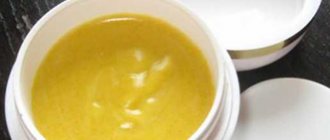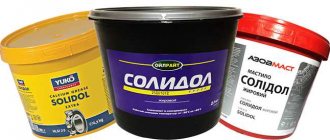From its introduction until the end of the 20th century, Solidol grease was extremely popular. It was used for most components of industrial equipment, agricultural and automotive equipment.
The volume of production of technical grease in different years ranged from 30 to 70% of the total quantity of all produced greases.
It is not surprising that such a name became a household name - any grease was called (and is still sometimes called) grease.
In this article we will take a closer look at the legendary lubricant and find out what grease is made from, what types it comes in, its advantages and disadvantages, where and how it is used.
What is Solidol?
The name "solidol" comes from the Latin words solidus
, i.e.
hard, dense and oleum
, i.e. oil. Another outdated name for grease is “grease”.
The basic industrial liquids that make up grease are petroleum oils, i.e. petroleum fractions selected after the production of gasoline. A calcium or sodium soap thickener is added to these oils.
Depending on the raw materials used, it can have colors ranging from light yellow to dark brown.
Thus, grease is a general purpose plastic anti-friction lubricant.
The main functions of technical solid oil are to reduce friction and prevent intense wear of rubbing parts.
Properties and composition of grease-based ointments
Ointments based on grease have been used for more than 60 years, approximately since the middle of the last century. According to reviews, this is the most popular remedy for topical treatment of psoriasis. Their use allows you to achieve the following effect:
- peeling of the skin is reduced;
- itching and burning disappear;
- the affected area gradually decreases;
- epithelialization of affected areas accelerates;
- the process of normal horn formation on ulcerated and eroded surfaces is enhanced (keratoplastic effect).
Today, quite a lot of solid oil-based products are used in medicine. Their effectiveness depends on the active ingredients included in the ointments, but the base itself also plays a significant role (whether the grease is synthetic or fatty, as well as the degree of its purification).
In accordance with the active substances (AI) included in the composition of external products with grease, they can be divided into 3 main groups:
- The active ingredients are mineral components (for example, Rybakov’s ointment).
- Exclusively herbal ingredients were used as additives (Markina ointment, Antipsor, Kartalin).
- The ointment contains both mineral and herbal components (Magnipsor, Makeev ointment).
Many people prefer to treat psoriasis with purified solid oil, without any additional components.
Types of Solidol
Based on their origin and production method, solid oils are divided into:
- Fatty – they use fatty acids from vegetable oils as thickeners
- Synthetic – synthetic fatty acids are used in their production
The first ones (Solidol-Zh) have slightly higher performance and are considered to be of higher quality. At the same time, artificial synthetic solid oil (Solidol-S) has superiority in some indicators and is much cheaper, therefore it is also widely used for servicing industrial equipment.
Based on the method of application and consistency, solid oils are divided into ordinary and press solid oils. The latter are characterized by lower viscosity and are used for pumping into components through grease nipples or using centralized lubrication systems.
It is known that solid oil does not have a very high load-bearing capacity. To obtain higher properties, graphite was added to the lubricant.
One of the most popular such materials is grease with graphite - silver-colored lubricant USsA. Due to the addition of 10% coarse graphite powder to its composition, it has increased extreme pressure properties and conductivity.
It was noticed that solid oil, originally conceived as an anti-friction lubricant, has a healing effect on the human body for certain diseases. It began to be used not only for technical, but also for medical purposes. This is how a division into technical and medical solid oils appeared, which undergo an additional thorough cleaning procedure during production.
The most popular ointments
Ungwethol
The active ingredient of the ointment is trinitrotoluene (TNT). Its share is 1.5%. Also includes:
- fat grease – 90%;
- sunflower oil;
- resorcinol;
- boric acid;
- benzoic acid;
- dimethyl sulfoxide;
- menthol.
Ungvetol has a pronounced antimicrobial and fungicidal effect. Reviews from experts indicate a fairly high effectiveness of using this ointment with solid oil in the treatment of psoriasis. In patients with the stationary stage of the disease, significant improvement occurs in 70% of cases (subject to an appropriate diet). Relapses are associated with the presence of provoking factors: poor diet, infectious diseases or mental trauma.
Magnipsor
This is one of the most popular ointments for psoriasis based on solid oil, which effectively eliminates the external manifestations of the disease. During the production of ointment, the DV is combined with an ointment base (fatty grease) with further processing of the resulting compound. Magipsor has a keratolytic, resolving and reducing effect.
The active ingredients of the ointment are:
- mineral components (including Dead Sea salts);
- alcoholic herbal extracts;
- root extracts of medicinal plants (burdock, etc.);
- vegetable oils: pumpkin, sea buckthorn, tea tree.
In case of persistent addiction to the base drug, analogues are prescribed: Magnipsor-5, Magnipsor-S. Magnipsor-M. The affected areas are lubricated up to 2 times a day. The ointment can be washed off after 2 days (if necessary, daily rinsing is possible). The duration of treatment is 1-1.5 months. In rare cases, itching and skin irritation may occur.
Antipsor
The components of the ointment are:
- complex oil and water extracts of medicinal plants: calendula, tripartite, birch leaves, celandine, marsh cudweed;
- elements of the chitinous pattern of the Pacific fauna.
The fat base consists of:
- lanolin;
- medical Vaseline;
- linseed oil;
- camphor;
- fat grease.
Treatment of psoriasis with Antipsor lasts on average 20-70 days. The product may cause allergies. Its manifestations are:
- worsening itching;
- the appearance of a pustular rash;
- swelling of the treated area.
Technical characteristics of Solidol
The main technical characteristics of grease, as for any grease, are usually the operating temperature range, resistance to various environments, as well as a number of additional parameters and properties.
The upper threshold of operating temperatures does not exceed +65…+70 °C, and the lower threshold is about -25 degrees. However, this temperature does not ensure complete freezing. In loaded components of powerful mechanisms, this material can work even at -50 °C.
It is noteworthy that when melting and subsequent solidification, the lubricant loses many of its performance characteristics and is unsuitable for further use.
One of the most important indicators for solid oil is its high resistance to water and moisture.
Water is one of the components of the lubricant and acts as a stabilizer in it. Solid oil practically does not dissolve in cold water, and upon contact with it it becomes covered with a whitish coating from interaction with calcium salts. The water content in grease does not exceed 3%.
Solid oils have high colloidal stability and practically do not release oil. Synthetic solid oils are more stable in this regard, which allows them to be stored for a long time (up to 5 years or more).
Advantages of technical Solidol
- The main advantage of technical grease over other lubricants is its excellent price-quality ratio
- It has characteristics sufficient to service most components operating both under normal conditions and under the influence of increased loads, water, moisture and dust
- Solidol is not a toxic substance
- The lubricant can work under conditions of exposure to dust, rain, snow, and sun, and has high protective anti-corrosion characteristics. This allows the use of grease as not only anti-friction, but also preservation compounds
Litol - description, characteristics and applicability.
Litol grease was developed in the Soviet Union in the 70-80s of the 20th century as a material that, over time, is intended to completely replace grease.
Mineral oil thickened with lithium soaps of stearic acids is used as a lithol base. This thickener made it possible to expand the range of operating temperatures - the lubricant works perfectly up to +120...+130 °C.
The most famous and versatile material from the series is Litol-24. The additives this composition contains prevent the process of accelerated oxidation of the lubricant. The consistency, load-bearing capacity, water-repellent properties and many other characteristics of the material turned out to be sufficient for its use in most components of modern mechanisms.
Currently, Litol is perhaps the most universal and multifunctional lubricant for mechanisms operating under normal operating conditions.
What is the difference between Solidol and Litol?
Solidol and litol are the most common and well-known greases in Russia. However, not everyone knows how these lubricants differ from each other and in which cases solid oil can and should be used, and in which cases it should not be used.
To dot the i's
"in this matter and to understand that litol is not a substitute (analogue) of solid oil in all cases, let us consider the main differences between lithol and solid oil.
Lithium soaps are used as a thickener in lithol, and calcium or sodium soaps are used in solid oil. The thickener, as is known, determines a set of basic physical properties of lubricants.
The upper limit of the operating temperature of lithium greases is about +130 °C, while for calcium grease it is only about +70 °C.
Solid oil is more water resistant than lithols; it is not washed out of units, so it can be used in conditions of constant exposure to moisture.
For some structural materials, lithol is aggressive in the presence of moisture, while solid oil is more inert and does not damage parts, for example, made of aluminum and its alloys.
In terms of cost, solid oil is superior to lithol - it is 2 or more times cheaper.
Now that the main differences are known, you can easily make a choice in favor of one material or another for various applications.
Precautionary measures
In some cases, solid oil can cause allergies. To avoid this, before starting treatment you need to conduct a test: lubricate the skin near the elbow with ointment. If no reaction occurs within 30 minutes, you can apply grease to a small area with psoriatic rashes. If itching, peeling or redness increases, the product should not be used.
The best results can be achieved by combining local treatment with solidol with cleansing the body and following an appropriate diet. An important condition for the effectiveness of therapy is also the elimination of stress.
Solidol - or, as it was previously called, grease - is a plastic thick lubricant based on calcium soap. Its functional temperature is about 70 degrees. The color is light yellow or brown. It is practically indelible with water, so it is mainly used in the mechanical industry: in devices that operate in conditions of high humidity and are not exposed to heat.
Application area
The scope of application of solid oil is determined by the properties, advantages and disadvantages that we discussed above. Solid oil is not recommended for lubricating components and mechanisms that are exposed to high temperatures. However, it works great in wet conditions.
Cars
Solid oil is used when servicing cars to lubricate unloaded and lightly loaded sliding friction units - door hinges and locks, latches, trunk and hood locks, locking mechanisms, window lift units, pedal bushings, seat slides, levers (for example, hand brake).
In domestic cars of early modifications, for example, GAZ-21, GAZ-24, it was necessary to frequently lubricate the front suspension joints. Maintenance was carried out by spraying with grease.
Solid oil is practically not used on modern cars, since it is incompatible with plastic and rubber materials, which are widely used in vehicle components.
Mechanical and power tools
Solid oil is effective as a lubricant for many mechanical and electrical tools. You just need to remember the low threshold of upper operating temperatures and do not use the composition in high-speed mechanisms that can become very hot.
Thus, it is not recommended to put lubricant in the gearbox of an angle grinder or drill. At the same time, solid oil is quite suitable for lubricating hand-held mechanical tools and low-speed drives, for example, winches, hoists, and vices.
Industry
In industry, solid oil has found wide application in various equipment units. It is used not only as a lubricant, but also as a preservative.
The grease is used to lubricate gate hinges, locks, and various mechanisms located in the open air.
Belt conveyors, conveyor lines, lifting mechanisms, hinges, hydraulic rods, bearing surfaces of rotary devices, gears and low-speed bearings of large diameters, powerful chain drives, units equipped with grease nipples are mostly still serviced with affordable, effective and cheap solid oil.
This composition has excellent preservative properties and reliably protects metal working tools, machines and mechanisms from corrosion. It is especially in demand for protection during storage of parts made of high-speed steels.
Country applications
In dacha conditions, solid oil also turns out to be extremely useful. It is used to lubricate garden mechanisms, wheel axles of garden carts, pumps, and working tools.
Parts and tools treated with this lubricant are stored for years and decades under conditions of exposure to moisture over a wide temperature range.
Another unusual use of the composition is as a garden varnish. It is used to lubricate fresh cuts of trees and shrubs, preventing their diseases and damage.
Medicine
Many people have heard about the use of solid oil to treat various human diseases. However, it should be borne in mind that for these purposes the composition used is not the one that is used to lubricate various mechanisms.
Medical grease has almost the same composition and is prepared using similar technologies from natural fatty acids, but, unlike conventional lubricant, it is then thoroughly cleaned. Purified solid oil is used to heal wounds, ulcers, abscesses, and treat psoriasis.
Currently, the industry produces a huge number of greases of various compositions, purposes, and areas of application. In terms of performance properties and characteristics, they are much superior to Solidol. However, due to its minimal cost and its versatility, this legendary lubricant is still in demand and is produced by numerous manufacturers in huge quantities.
The use of solid oil in folk medicine
Among the recipes of traditional medicine there are many recommendations on how to treat psoriasis with solid oil. It is used in its pure form or serves as a fatty base for home remedies.
- Mix 250 g of purified grease, two tablespoons of bee honey and ¼ tube of regular baby cream. Apply the resulting product to the affected areas 1 or 2 times a day. To get the best result, it is recommended to add ½ teaspoon of sulfur powder, chicken egg white, and a teaspoon of rose hip and chestnut ash to the ointment (can be replaced with birch ash). If the product is not effective enough, crushed celandine herb (1.5 tbsp) is also added to it. Simultaneously with the external use of the resulting cream, you can drink herbal tinctures to improve immunity.
- The method proposed below is as simple as possible. The essence of therapy is to lubricate the localized areas of psoriatic rashes with solid oil. First, it is left for 20 minutes, gradually increasing the exposure time to 1 hour. Solid oil should be smeared with a greasy layer. For rinsing, it is best to use tar soap.
- Pour 100 ml of water into ground elecampane root (4 tbsp) and keep in a water bath for about a quarter of an hour, then add grease. After mixing thoroughly, apply the product to the affected areas for 1 hour. To wash off, use tar, baby or laundry soap.
- Mix solid oil, 2 egg whites and linden honey. For 14 days, lubricate the plaques with the resulting ointment, then prepare the product according to a similar recipe, adding crushed dried celandine to it, and continue treatment of psoriasis for another 14 days.
- Ash from rosehip branches and oak bark (25 g each) is mixed with solid oil (100 g), celandine (10 g) and egg white. The mixture is infused for 2 weeks. Apply the prepared product to the skin three times a day.










